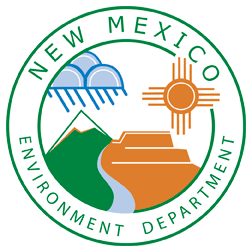This page includes current permit templates, permit general conditions, the basis for permit conditions in the monitoring protocols, historical rule interpretations, and other guidance that ensures consistency in air quality permitting in New Mexico.
Permit Templates
Permit template language and monitoring protocols were developed in collaboration with permit writers, management, the Enforcement & Compliance Section, industry, and the public. Our goal is to keep the permit language consistent:
- to apply the science equally to all permittees, so no facility has a commercial advantage over other facilities,
- to provide applicants and the public with some certainty regarding what permit language to expect for common situations,
- to streamline the permit writing process using quality conditions that have been vetted by stakeholders and approved by management, and
- to increase compliance by ensuring permittees with multiple permits have as much consistency between their permits as possible.
Document Change Request Procedure: AQB welcomes collaboration from all stakeholders. If you would like to comment on permit template language or a monitoring protocol, please submit a tracked changes version with your requested changes to the Permit Programs Manager. Add sufficient comments to ensure your point of view is well documented and your arguments are well presented.
New Source Review Construction permits
NSR Permit Template Part A (6/30/2021)
NSR Permit General Conditions Parts B & C (12/1/2022)
NSR Permit History of Template Changes (12/1/2022)
Title V Operating Permits
TV Permit Template Part A (3/20/2022)
TV Permit General Conditions Parts B & C (12/1/2022)
TV Permit History of Template Changes (12/1/2022)
Streamline New Source Construction permits
Streamline Permit Template Part A (3/24/2022)
Streamline Permit General Conditions Parts B & C (12/5/2022)
Streamline Permit History of Template Changes (12/5/2022)
Monitoring Protocols (chronological)
| Document Title | Version Date | Template Change document | Synopsis of last Significant Change(s) |
| Monitoring Fugitive VOC & HAPs Monitoring Fugitive VOC & HAP Decision Tree | 4/19/17 | Revised 4/19/17 | Revised the MRR text and added a Decision Tree |
| Flare Monitoring Protocol – Regulatory | 11/8/2016 | Initial Publication | Initial Publication |
| Monitoring IC Engines | 5/23/2016 | Update | This version includes some minor recommended revisions to the IC Engine and Turbine Monitoring Protocols related to the Periodic Emissions Tests sections in both, specifically, regarding testing frequency and monitoring periods. |
| Monitoring Turbines | 5/23/2016 | Update | This version includes some minor recommended revisions to the IC Engine and Turbine Monitoring Protocols related to the Periodic Emissions Tests sections in both, specifically, regarding testing frequency and monitoring periods. |
| 40 CFR 64 CAM Table Format | 10/31/2013 | Initial Publication | Initial Publication |
| Monitoring Heaters & Boilers | 3/20/2013 | Initial Publication | Initial Publication |
| Monitoring Tanks & Loading | 11/13/2012 | Initial Publication | Initial Publication |
| Monitoring Glycol Dehydrators | 5/23/2011 | Initial Publication | Initial Publication |
| Monitoring Turbines – Graph | 9/23/2010 | Initial Publication | Initial Publication |
| Monitoring IC Engines – Graph | 3/6/2015 | Initial Publication | Initial Publication |
| Monitoring Glycol Dehydrators – Graph | 9/22/2010 | Initial Publication | Initial Publication |
| Monitoring Gas-Fired Heaters – Graph | 5/28/2009 | Initial Publication | Initial Publication |
Guidance Documents (Chronological)
| Document Title | Version Date | Document Description |
| Guidance on What is Creditable for PER Calculations | 1/3/2020 | This guidance provides clarification on what is creditable for potential emission rate calculations for equipment voluntarily controlled in Notices of Intent. |
| Guidance on the TSP Repeal | 5/6/2019 | This guidance addresses the many questions we have received concerning the Repeal of the TSP NMAAQS. It also addresses many other issues yet to be questioned. |
| Guidance on Part 72, Subsection 211 – Permit Cancellations | 7/13/2017 | The primary focus of this guidance addresses whether Subsection 211 (Permit Cancellations) of Part 72 (Construction Permits) addresses facilities as a whole or whether it applies to individual units as well. |
| Guidance for Aggregate Handling, Storage Piles and Haul Road Emissions | 1/1/17 | Department accepted default values for NOI and NSR applications for Aggregate Handling and Storage Piles calculations and NSR Haul Road calculations |
| GHG Issues and Answers | 5/20/16 | How to address GHG applicability in permit applications |
| Guidance on Implementation of the 1 hour NO2 and SO2 Standards | 5/09/16 | NMED Air Quality Bureau is implementing additional dispersion modeling requirements for future permit applications submitted under the construction permit regulation, 20.2.72 NMAC.The National Ambient Air Quality Standards (NAAQS) include a 1-hour nitrogen dioxide (NO2) standard of 100 parts per billion (ppb) and a 1-hour sulfur dioxide (SO2) standard of 75 parts per billion (ppb). Because of inadequate modeling methods for demonstration of compliance with these standards, NMED initially did not require applications for minor source air quality permits to include compliance demonstrations for these pollutants. Since then the computer model and modeling guidance has improved, so it is reasonable to require modeling for these standards. 20.2.72.203.A(4) NMAC requires permit applications to include a compliance demonstration for each applicable air quality standard. |
| Guidance and clarification Regarding Applicability of 20.2.35 NMAC | 3/4/2016 | This guidance explores the issue of natural gas processing plants utilizing acid gas injection (AGI) and the applicability of “sulfur released in plant processes” to permitted SSM/M. |
| Public Notice Guidance & Templates | Various | The Public Notice guidance and templates are specific to the application types. They are available on those web pages and may be included within the application forms. |
| Permitting Guidance for Non-Road Engines | 4/2/2014 | This guidance explores the issue of whether the Department has the authority to regulate Non-Road Engines and comes to the conclusion that it does. |
| Air Curtain Incinerators (ACI) Permitting Guidance: ACI Permitting Guidance (Dec. 20, 2024) | 12/20/2024 | Federal regulations changed in 2024, no longer requirement a Title V permit for Air Curtain Incinerators. Please refer to the revised guidance. *Updated guidance coming soon |
| Guidance for Determination of Occupied Structure | 3/14/2014 | Clarification of Occupied Structure definition as listed in 20.2.72.301.B(6) |
| PSD Pre-application Guidance | 3/7/2014 | Pre construction monitoring may be required before a PSD application is submitted |
| Cooling Tower Particulate Emissions | 9/9/2013 | Calculating TSP, PM10 and PM 2.5 for Cooling Tower Particulate Emissions |
| Vasquez-Beggs Flash emissions calculation Spreadsheet | 7/2/2010 | Oil & Gas Vasquez-Beggs Emission Factors |
| Single Source Determination Guidance | 5/7/2010 | How to address Single Source Determination for permit applications |
| Permitting Checklist for Concrete Facilities | 2/1/2007 | For regular NSR permits (not GCP-5) using the Universal Application Form |
| Link to AP-42 Emission Factors | EPA web site | Emission Factors |
Startup, Shutdown and Maintenance Guidance Documents (Chronological)
| SSM guidance for submitting a reduced form set application | 8/24/2011 |
| Startup, Shutdown, Maintenance Emissions in Permits | 7/29/08 |
Procedures
These procedures are intended to serve as general guidance and are in no way a formal statement of Department policy. Unique operating conditions may result in different determinations and may require a site-specific analysis to accurately determine requirements and applicability.
| Procedure Subject | AQB Procedure Number |
| Applicability of 20 NMAC 2.18, 2.33, and 2.34 | 02-005.01 |
| Use of Proper Forms for New Source Review Permit Applications | 02-011.00 |
| Turbine/Reciprocating Engine Derating | 02-002.00 |
| Air Quality Bureau Announcement of Inspections | 02-009.00 |
| Electronic Kill Switches | 02-003.00 |
| New Source Permit Review Applications – Ruling Administratively Incomplete, Requesting More Information, Denials, and Extensions | 02-013.00 |
| Guidance For Operating/Production Limitations | 02-004.00 |
| Guidance for Pre construction Activities | 02-006.01 |
| Initial Testing Requirements | 02-008.00 |
| Replacement of Identical IC Engines and Turbines | 02-007.00 |
| Air Quality Bureau Civil Penalty Policy (10/14/2016) | 02-010.00 |
| Exemption Policy | 02-012.00 |
If you are not familiar with air quality permitting in New Mexico, we suggest a pre-application meeting with our staff prior to you putting effort into the application process. Use the Contact Us link to schedule a pre-application meeting.

